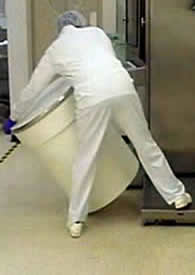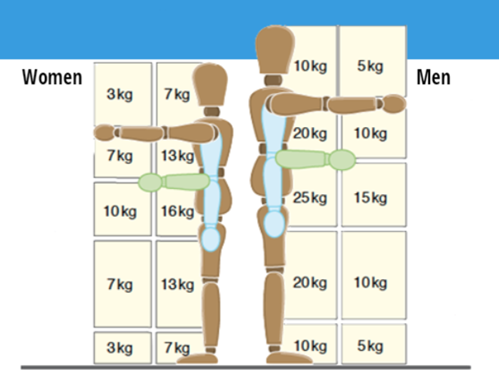The term 'manual handling' or 'moving and handling' is defined as:
"The transportation or support of a load by human effort alone."
This effort may be applied directly, for example pushing, pulling or carrying a load or indirectly using a rope or a lever.
In the Manual Handling Operations Regulations 1992 (as amended) (MHOR), the Regulations define manual handling as: "...any transporting or supporting of a load (including the lifting, putting down, pushing, pulling, carrying or moving thereof) by hand or bodily force". The load can be an object, person or animal.
Until a few years ago, accidents caused by the manual handling of loads were the largest single cause of over 7-day accidents reported to the Health and Safety Executive (HSE). The Manual Handling Operations Regulations 1992, as amended in 2002 ('the Regulations or MHOR') were introduced to help reduce these accidents and apply to a wide range of manual handling activities, including lifting, lowering, pushing, pulling or carrying. The load may be either animate, such as a person or an animal, or inanimate, such as a box or a trolley.
However, accidents due to poor manual handling technique, still account for over 25% of all reported accidents and in some occupational sectors, such as the health service, the figure rises above 50%. So in 2003, the NHS in Wales developed the All Wales Passport scheme in Manual Handling. This was to ensure high standards and consistency of manual handling within the NHS in Wales. This has since been adopted by many other NHS trusts and healthcare sectors to try and reduce injuries occurring from manual handling activities.
The other more broad legislation that applies to all work activities not just manual handling is the Health and Safety at Work etc Act 1974 (also referred to as HSWA, the HSW Act, the 1974 Act or HASAWA). This act places a legal duty on employers and employees to comply with all of their health and safety duties and requirements, to take reasonable care of workers and others who may be affected by manual handling activities.
The HSW act and the Manual Handling Operations Regulations 1992, as amended in 2002, place a legal responsibility on employers to carry out risk assessments on any manual handling activity, where there is a risk of personal injury or harm to others. Also to ensure that suitable training is supplied to employees engaged in manual handling activities.
Commodious manual handling online training course covers these legal duties in much more detail and also leads to a RoSPA and ISO9001 quality certificate. This is very useful to demonstrate that the risks of manual handling activities are fully understood and how to manage and reduce these risks.
Tile or Tileo are acronyms to help you prepare a manual handling risk assessment. The acronym 'TILE' stands for:
TASK, INDIVIDUAL, LOAD, ENVIRONMENT by considering each of these factors a suitable risk assessment can be completed. Tileo simply adds OTHER FACTORS to the tile acronym.
What does ICC stand for in manual handling - this is the Incident Contact Centre (ICC) a 'one-stop' reporting service for work-related health and safety incidents, such as an injury from manual handling that needs reporting under RIDDOR. The ICC is a primarily a call centre, open from Monday to Friday on 0845 300 99 23.
Manual handling can be avoided completely, but it is dependant on the task and situation. Often it cannot be avoided completely.
Using machines in factory and warehouse work can often completely replace human effort. By replacing manual handling tasks with machines, such as forklift trucks, hoists and cranes. However there will still be occasions when hazardous manual handling cannot be avoided completely such as delivering heavy parcels, brick-laying, carpet fitting, nursing and many other trades, professions and occupations.
In any manual handling activity where more than one person is involved, then good communication is vital to reduce the risk of injury. A nurse trying to move a patient can greatly reduce the risk by communicating to the patient exactly what they are attempting to do and getting the patient to assist as much as possible.
For example, in a furniture removal team good communication is vital to reduce the risk of manual handling injuries. In any team manual handling activity, all members of the team must know exactly what is expected of them, and good communication is obviously how this is achieved.
Safe manual handling is not simply determined by reducing the weight being handled. An “ergonomic” approach to manual handling is needed to reduce the risks in which the contributory factors from the TILE acronym are considered:
Task – e.g. duration and frequency
Individual capability – e.g. age & strength
Load – e.g. shape / weight
Environment – e.g. confined spaces, steps
Ideally avoid all heavy and awkward manual handling. Providing manual handling training is essential, but will not eliminate potential risks alone.
The risk can be reduced in other ways, by changing the load or altering the working environment to make handling safer. Manual handling aids should be used where-ever applicable.
Here are two examples of manual handling activities that are high risk where an ergonomic approach would reduce the risk.

Worker stretching up to reach box.
The box is stored above shoulder height and requires the operator to overstretch to retrieve it, with the possibility of the box falling and injuring the worker, or the worker overstretching. Simply re-positioning the height of the storage area would reduce the risk from this manual handling activity.

Worker manoeuvering large drum on to scale.
This operator must roll this heavy drum onto the weigh scales which are raised. This requires an overall awkward posture as well as potentially being above the recommended lifting guidelines. Re-positioning the scales so that the drum could be more easily ‘slid’ onto them, or a manual handling aid such as pump up trolley could be used.
The simplest method is via an online training course such as that provided by Commodious. The course downloads immediately and takes around 55 minutes to complete and then a RoSPA and ISO 9001 quality assured manual handling certificate is issued that is instantly awarded and downloadable.
Manual handling training certificate expiry dates.
There is no legal or mandatory expiry date on training certificates, but some industry sectors, insurance companies and registration organisations such as CHAS, SafeContractor, SMAS and other members of the SSIP have their own recommended refresher training dates. Many sectors and organisations insist upon a manual handling training certificate before any manual handling activity takes place on site.
The HSE web site states that refresher training should be carried out whenever it is felt necessary (for example a change in working condition, the introduction of new equipment, staff or working practices or when it is felt necessary to undertake refresher training). Many registration bodies such as CHAS, SafeContractor, ConstructionLine and other members of the SSiP scheme all recommend that re-training is done every 3 years on all courses.
Commodious view is that every 3 years is good practice and definitely every 5.
A common misconception is Manual Handling Operations Regulations only apply to the lifting, lowering and carrying of loads, they also apply to pushing and pulling such as using a wheelbarrow or sack cart.
Although when people push and pull, instead of lifting and carrying, less effort is required. There may still be a risk of musculoskeletal disorders (MSDs). So it still may be necessary to carry out a suitable and sufficient assessment of this risk of manual handling injury.
The HSE have a useful online tool to help with this sort of risk assessment, called Risk Assessment of Pushing and Pulling (RAPP tool).
How many manual handling operations per hour is also dependant on the individual and the weight of the load. The HSE produced a guideline, a diagram of which is shown below.

The weights are guidelines only, they are not legal limits and are based on infrequent operations. For repeat tasks (over 30 operations per hour) you would reduce the stated weights in each sector.
As a rough guide, reduce the weights by 30% if the operation is repeated once or twice a minute, by 50% if it is repeated 5-8 times a minute, and by 80% where it is repeated more than 12 times a minute.
Looking for information on TILE? Consider reading our detailed article: Manual Handling: What does TILE stand for?